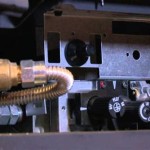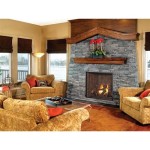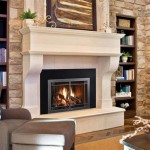Heatilator 3-Sided Wood Burning Fireplace: Design, Functionality, and Considerations
The Heatilator 3-sided wood-burning fireplace represents a significant architectural feature in residential and commercial design. Combining the ambiance of a traditional wood fire with a contemporary aesthetic, these fireplaces offer a unique viewing experience from multiple vantage points within a room. This article delves into the design, functionality, and essential considerations associated with Heatilator 3-sided wood-burning fireplaces, providing a comprehensive overview for prospective buyers and building professionals.
A 3-sided fireplace, as the name suggests, features three open sides, typically enclosed with glass, that allow for unobstructed views of the fire. This design contrasts with traditional fireplaces that have a single opening facing the room. The multi-sided configuration creates a more immersive and visually engaging experience, making it a focal point in open-concept living spaces. Heatilator, a recognized brand in the fireplace industry, offers various models of 3-sided wood-burning fireplaces, each designed to meet specific heating and aesthetic requirements.
The appeal of a wood-burning fireplace lies not only in its visual charm but also in the warmth and ambiance it provides. The crackling sound of burning wood, the scent of smoke, and the radiant heat contribute to a cozy and inviting atmosphere. For many, a wood-burning fireplace evokes a sense of tradition and nostalgia, making it a desirable addition to their homes. Heatilator's 3-sided models aim to amplify these qualities by extending the viewing area and distributing warmth more evenly across the room.
Design Considerations for Heatilator 3-Sided Fireplaces
When incorporating a Heatilator 3-sided wood-burning fireplace into a building design, several design considerations must be addressed. These encompass architectural integration, spatial planning, ventilation, and aesthetic choices. A poorly planned fireplace can detract from the overall design, while a well-integrated unit can enhance the ambiance and functionality of the space.
The first design consideration is architectural integration. A 3-sided fireplace is not simply an add-on feature; it should be considered during the initial planning stages of a building project. The fireplace’s dimensions, weight, and required clearances will influence the structural design of the surrounding walls and floor. Load-bearing capacity, framing, and foundation requirements must be assessed and incorporated into the architectural plans.
Spatial planning is another crucial aspect. Due to its multiple viewing angles, a 3-sided fireplace typically functions best in a central location within an open-concept space. It can serve as a natural divider between living areas, such as a living room and a dining room, while maintaining visual connectivity. The placement of furniture and other fixtures should be carefully considered to ensure optimal viewing angles and to maintain safe distances from the fireplace opening. Accessibility for refueling and cleaning should also be factored into the spatial layout.
Ventilation is paramount for any wood-burning fireplace, and a 3-sided model is no exception. A proper flue system is essential to safely and efficiently exhaust smoke and combustion gases from the fireplace. Building codes and regulations dictate specific requirements for chimney height, diameter, and materials. A professional installer should be consulted to ensure that the ventilation system meets all applicable standards. Downdrafts and backdrafts can pose serious health and safety risks, highlighting the importance of a properly designed and installed ventilation system.
Aesthetic choices play a significant role in the overall appeal of the fireplace. Heatilator offers a range of design options, including different firebox sizes, door styles, and trim finishes. The choice of materials for the facing of the fireplace, such as brick, stone, or tile, can complement the surrounding décor and architectural style. The fireplace surround should be designed to withstand high temperatures and be easily cleaned. The aesthetic integration should strive to create a seamless transition between the fireplace and the surrounding environment.
Functionality and Operational Aspects
The functionality of a Heatilator 3-sided wood-burning fireplace involves several operational aspects, including fuel selection, combustion efficiency, heat output, and maintenance. A thorough understanding of these factors is essential for safe and efficient operation.
Fuel selection is a critical determinant of fireplace performance. Seasoned hardwoods, such as oak, maple, and birch, are generally recommended for wood-burning fireplaces. These woods burn hotter and produce less smoke and creosote compared to softwoods. The wood should be properly dried (seasoned) for at least six months to reduce moisture content. Wet or green wood burns inefficiently, generates excessive smoke, and increases the risk of creosote buildup in the chimney. Creosote is a highly flammable substance that can lead to chimney fires. The Environmental Protection Agency (EPA) provides guidelines and best practices for wood-burning fireplaces, including fuel selection and combustion techniques.
Combustion efficiency is a measure of how effectively the fireplace burns wood and converts it into heat. Heatilator's 3-sided fireplaces are designed to meet EPA emission standards, indicating that they burn wood cleaner and more efficiently than older, non-certified models. Key features that contribute to combustion efficiency include a well-sealed firebox, a properly sized air intake, and a baffle system that promotes complete combustion. Efficient combustion minimizes the amount of unburned particles and gases released into the atmosphere, reducing air pollution and improving indoor air quality.
Heat output is an important consideration, particularly in colder climates. The heat output of a wood-burning fireplace is measured in British Thermal Units (BTUs). The required heat output will depend on the size of the room, the insulation level of the building, and the desired temperature. Heatilator offers models with varying BTU ratings to accommodate different heating needs. The 3-sided design can enhance heat distribution by radiating heat in multiple directions. However, it's important to note that wood-burning fireplaces are not typically designed to be the primary heating source for an entire home. They are best suited for supplemental heating and creating ambiance.
Regular maintenance is essential for the safe and efficient operation of a Heatilator 3-sided wood-burning fireplace. This includes cleaning the firebox, removing ashes, and inspecting the chimney. The chimney should be inspected and cleaned annually by a certified chimney sweep to remove creosote buildup. A clogged chimney can restrict airflow, increase the risk of chimney fires, and reduce the efficiency of the fireplace. The glass doors should also be cleaned regularly to maintain visibility. The fireplace should be inspected for signs of damage, such as cracks in the firebox or loose bricks. Addressing minor issues promptly can prevent more serious problems in the future.
Key Points Regarding Safety and Regulatory Compliance
Safety is of paramount importance when operating a wood-burning fireplace. Heatilator 3-sided models are designed with safety features, but users must adhere to safety guidelines to prevent accidents and ensure proper operation. Regulatory compliance is also essential, as wood-burning fireplaces are subject to various building codes and environmental regulations.
One key safety precaution is to never leave a fire unattended. Sparks or embers can escape from the firebox and ignite nearby flammable materials. A fireplace screen or mesh door should always be in place when the fireplace is in use to contain sparks and embers. Combustible materials, such as furniture, curtains, and newspapers, should be kept a safe distance from the fireplace opening. Children and pets should be supervised around the fireplace to prevent burns or other injuries.
Carbon monoxide (CO) poisoning is a serious risk associated with wood-burning fireplaces. Carbon monoxide is a colorless, odorless gas produced by incomplete combustion. It can accumulate in the home if the fireplace is not properly ventilated. Symptoms of CO poisoning include headache, dizziness, nausea, and confusion. In severe cases, CO poisoning can be fatal. A carbon monoxide detector should be installed in the home near the fireplace to alert occupants of dangerous CO levels. The detector should be tested regularly to ensure that it is functioning properly.
Building codes and regulations govern the installation and operation of wood-burning fireplaces. These regulations address issues such as chimney construction, clearance requirements, and emission standards. Permits may be required for the installation of a new fireplace or the alteration of an existing one. The local building department can provide information on applicable codes and regulations. Failure to comply with these regulations can result in fines or other penalties.
EPA regulations aim to reduce air pollution from wood-burning appliances. These regulations set emission limits for particulate matter, which is a major component of smoke. Heatilator's EPA-certified 3-sided fireplaces meet these emission standards. It is important to operate the fireplace in accordance with the manufacturer's instructions to minimize emissions. This includes using seasoned wood, maintaining a clean firebox, and ensuring proper ventilation.
Insurance considerations are also relevant. Homeowners should inform their insurance provider about the presence of a wood-burning fireplace. Some insurance companies may require inspections or specific safety measures to be in place. Failure to disclose the presence of a fireplace could affect the homeowner's insurance coverage in the event of a fire or other incident.
In summary, a Heatilator 3-sided wood-burning fireplace offers a unique combination of aesthetic appeal and functional heating. However, careful planning, proper installation, regular maintenance, and adherence to safety guidelines are essential for ensuring safe and efficient operation. Understanding the design considerations, operational aspects, and regulatory requirements associated with these fireplaces will enable homeowners and building professionals to make informed decisions and enjoy the benefits of a wood-burning fireplace responsibly.

Heatilator 42 Inch Three Sided Wood Burning Fireplace
Pier Three Sided Gas Fireplace Heatilator

Heatilator Gdfl4136ift Weiss Johnson Fireplaces
Pier Three Sided Gas Fireplace Heatilator

See Through Fireplaces Heatilator Mountain West S

Gas Fireplace Peninsula Heatilator Traditional Closed Hearth 3 Sided

Heatilator Fl92 The Fireplace King Huntsville Ontario Muskoka For Your Heating Cooling And Grilling Needs

Heatilator Constitution Wood Fireplace Fireside Hearth And Leisure
Multi Sided Wood Fireplaces Heatilator

Pier Direct Vent Peninsula Fireplace By Majestic Fine S Gas
Related Posts








